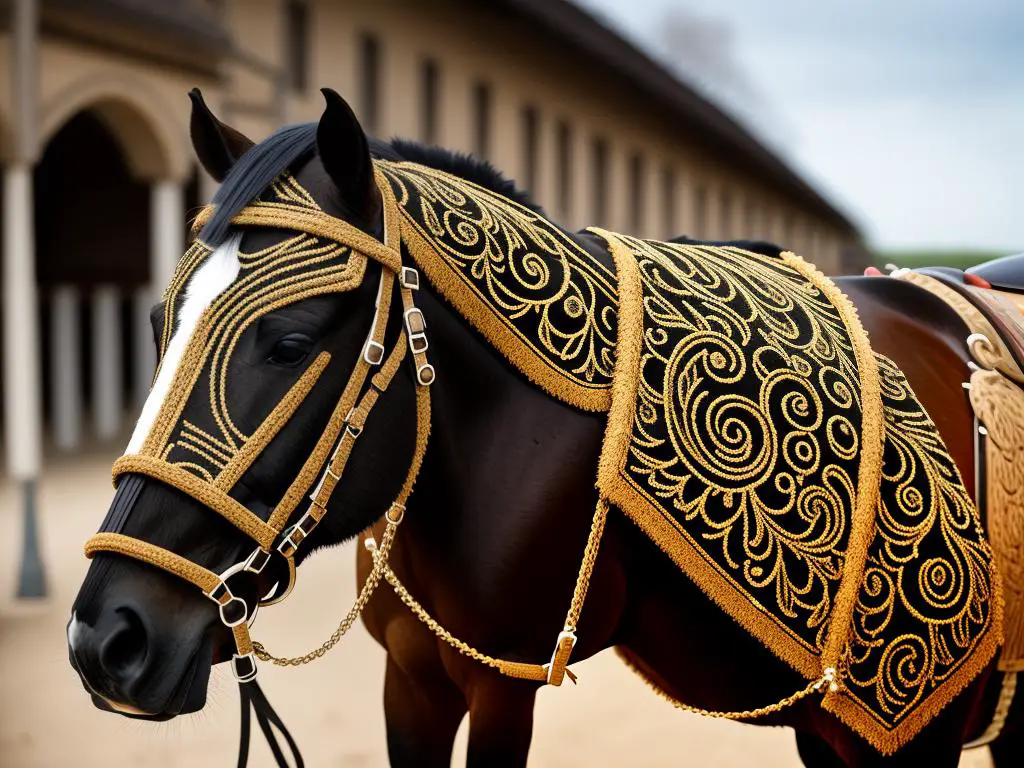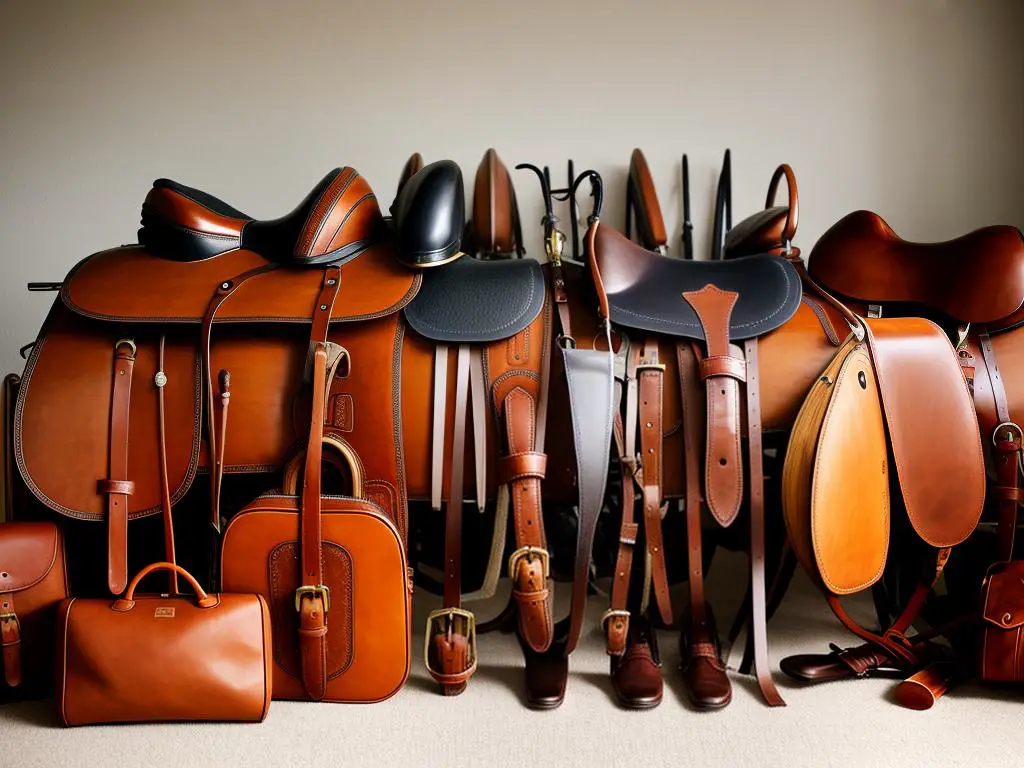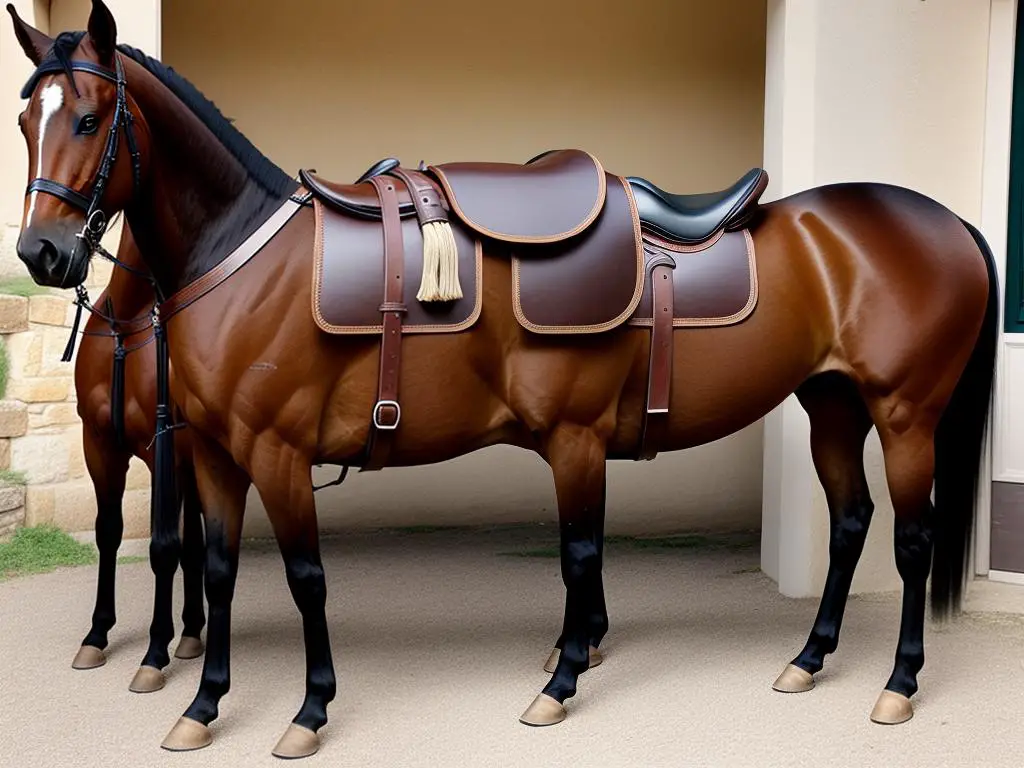Immerse yourself in the rich tapestry of French history as we journey through the evolution and significance of traditional French horse equipment. Not merely functional, each piece of gear tells a story of a centuries-old equestrian culture deeply intertwined with France’s history itself. From early designs to present iterations, French horse equipment speaks volumes about the country’s penchant for style, innovation, and excellence. The wide array of equipment such as saddles, bridles, horse clothing, and harnesses, reflect the influences of various equine activities in France, showcasing not only their commitment to performance but also to horse and rider’s safety and comfort. As we venture into the realm of French equestrian gear, we discover its marked influence and exceptional contribution to the global stage and comprehend the importance of its preservation in the face of modern advancements.
Table of Contents (Horspedia)
The Evolution of French Horse Equipment
The Origins of French Horse Equipment
The history of French horse equipment traces back to the Middle Ages, in which horses played a crucial role in warfare, agriculture, and transportation. During this period, the main type of equipment used was the war saddle, designed to keep the rider firmly in place during combat. It was typically built with a high pommel and cantle to offer the knight maximum protection and maintain balance. As for bridles, they were relatively simple, usually combined with a metal bit to control the horse.
Transition to Renaissance and Early Modern Era
The Renaissance and Early Modern Era saw fewer changes in French horse equipment. War saddles became less common due to the decline in mounted combat, replaced by riding saddles for travel and hunting purposes. The focus shifted to comfort and control rather than protection and stability. Bridles remained similar but often included more intricate designs reflecting the period’s focus on art and culture.
The Industrial Revolution and Its Impact
The Industrial Revolution brought about significant changes in French horse equipment. The advent of new technologies and industrial processes made it possible to produce stronger, more durable, and lightweight materials. Leather remained the dominant material for saddles and bridles, but its quality and durability improved significantly due to advanced tanning processes.
Metal bits became more refined, with distinctive types for different purposes – driving, dressage, and jumping. Harnesses too evolved, from simple leather strap systems to complex designs featuring padding and metal elements, offering greater comfort and control to the driver and horse.
The Modern Era and Current Trends
The modern era saw another phase of evolution in French horse equipment. Now, the overriding principles guiding the design and production of horse equipment are the horse’s comfort and well-being, rider comfort, and equipment longevity.
Leather is still the most common material for most horse equipment, but synthetic materials, especially for saddles and bridles, are on the rise too, due to their durability and ease of maintenance. Modern French horse equipment often incorporates design elements that accommodate the horse’s natural movements, reduce pressure points, and allow better communication between horse and rider.
Introduction
The story of French horse equipment chronicles the shifts in society, advances in technology, as well as the deepening comprehension of equine anatomy and behavior. Progressing from the heavy-duty battle saddles of the medieval period to the specialized tack in present times, French horse equipment has significantly evolved. Each epoch has made meaningful contributions that have shaped today’s horses’ utilitarian equipment.

Types and Functions of Traditional French Horse Equipment
A Survey of Traditional French Horse Equipment
The evolution of traditional French horse equipment, steeped in centuries of equestrian heritage, encompasses an array of established gear such as saddles, bridles, harnesses, and equine garments. Each piece of equipment serves a vital function in the upkeep, riding, and handling of horses. Moreover, they embody the rich legacy and refinement of French horsemanship.
French Saddles: A Blend of Comfort and Functionality
French saddles are esteemed for their exceptional craftsmanship. Constructed of superior quality leather, they are engineered to provide maximum comfort to both the horse and rider. The architecture of these saddles promotes a closer contact between the horse and the rider, enabling a smoother ride and better control. Traditional French saddles are categorized into two types – the Dressage saddles, tailored to provide a deeper seat for improved balance, and the Jumping saddles, designed for better freedom of movement during jumps.
Bridles: Mastery in Detail
French bridles constitute an essential part of traditional horse equipment. Manufactured from top-notch, resilient leather types such as cowhide or buffalo, French bridles ensure the perfect blend of strength and flexibility. Fine detailing and adjustable features cater to the comfort of the horse and allow better control to the rider. French bridles follow a minimalistic design approach – they are light, simple, and non-restrictive.
Harnesses: Symbols of Traditionalism and Utility
French horse harnesses, with their diverse designs and functions, accommodate various equestrian activities such as driving, horse pulling, and farm work. Traditional French harnesses especially designed for working horses often feature rich decorations and are more elaborate, symbolizing France’s rural heritage and love for horses. On the other hand, sport harnesses focus more on robust construction and efficient design to facilitate high performance.
Horse Clothing: Protection and Emblem of Culture
Traditional French horse clothing includes blankets, protective boots, and fly sheets. These items ensure the animal’s comfort, safety, and overall well-being. French horse clothing is renowned for its high-quality materials, durability, and fashionable designs, reflecting France’s reputation as a world leader in fashion. Each region in France has its unique style and pattern in horse clothing, reflecting local cultural nuances.
Comparison to Other Cultures
When compared to their counterparts in other cultures, French horse equipment stands out for its unparalleled focus on quality, functionality, and aesthetic appeal. French saddle makers, for instance, are famous worldwide for their attention to even minute details. French horse equipment is also associated with luxury and high-end craftsmanship due to the use of materials like top-quality leather and innovative designs. Their simplicity and ease-of-use set them apart from the often more complicated gear used in other cultures.
Emanating a rich historical background and merging art with utility, traditional French horse equipment underlines the essence of French equestrian culture. These sophisticated and high-quality tools have more than just a practical function – they act as brash symbols of French heritage and refinement.

Importance of Traditional French Horse Equipment in Equine Activity
The Role of Traditional French Horse Equipment in Equestrian Activities
In the realm of equestrian activities, traditional French horse equipment holds a place of remarkable significance. France is famous for its deep-rooted equestrian culture, which traces its roots back to the Middle Ages. This lengthy history birthed unique styles of horse gear, all meticulously crafted with a dual emphasis on the comfort of the horse and rider.
Horse Racing and Traditional French Horse Equipment
Horse racing, a popular sport in France, demands top-quality equipment to ensure the horse’s exceptional performance and safety. Traditional French horse gear such as racing saddles and bridles made of premium leather are distinctive for their lightness, thereby allowing horses to accommodate higher speeds without the burden of excessive weight. These saddles are also padded in strategic places, ensuring an increased comfort level for both horse and rider, crucial during high-speed races.
French Horse Equipment in Dressage
Dressage, an equestrian performance sport, is another field where traditional French horse equipment comes to the forefront. French Dressage saddles, for instance, are designed to offer a closer contact between the rider and the horse for nuanced communication, vital for complex dressage manoeuvres. French dressage bridles, on the other hand, facilitate harnessing the horse’s attention and responsiveness, serving as a primary control tool during performance.
Trekking and Farming: Equipping with French Tradition
Traditional French horse equipment is not limited to racing and dressage. In activities like trekking and farming, French harnesses and collars – which distribute weight evenly across the horse’s back and shoulders – play a crucial role. They reduce strains and potential injuries, improving the horse’s willingness to work and, consequently, productivity. Additionally, the equipment’s robust build quality ensures longevity, making it a cost-effective solution in long-winded farming activities.
In trekking, a recreational activity in the French countryside, equipment such as general-purpose French saddles are designed for the rider’s optimal comfort during hours-long journeys. The design of these saddles allows for a balanced seating position, providing stability while reducing tiredness.
Safety and Comfort: Core Principles in French Equine Equipment Design
Traditional French horse equipment is characterized by considerations for safety and comfort, for both the horse and rider. This emphasis on safety cannot be understated, given the potential risks involved in equine activities. French horse equipment, like safety stirrups and high-quality girths, are designed to prevent accidents, such as the rider’s feet getting trapped or the saddle from slipping.
The crux of traditional French horse equipment lies not just in the races and dressages it is used in, but the very essence of its function: enhancing performance while ensuring the safety and well-being of both horse and rider. This equipment, ingrained in the French tradition, evinces a masterful blend of craftsmanship and innovation. From the local pastures of France to equine activities the world over, French horse equipment has cast an influential shadow by setting high safety and performance standards.

The Influence of French Horse Equipment on the Global Stage
Traditional French Horse Equipment: A Legacy of Excellence
At the core of traditional French horse equipment lies a deep respect for the authenticity of commissioned equestrian techniques. These techniques prioritize horse comfort, gear durability, and effective riding. Their highly skilled craftsmanship and innovative design approach have garnered international acclaim, raising the bar for global equestrian trends.
Pioneering Innovation and Sleek Design in French Horse Equipment
The focus of French horse equipment first and foremost is horse comfort, a principle deeply entrenched in French equestrian culture. This emphasis promotes unprecedented innovation, showcased in their ergonomic saddle design and adaptable bridle structures. Such specialty features play a significant part in optimizing horse performance and guaranteeing the enduring lifespan of the equipment.
However, the defining characteristic of French horse equipment is not just its functionality but also its stunning aesthetic appeal. Renowned for its intricate detailing, extraordinary finish, and the utilization of premium materials such as luxury leather, French horse gear perfectly marries traditional and contemporary design elements. This versatile aesthetic caters to an array of unique rider inclinations across the globe.
Global Influence of French Horse Equipment
The specialized appeal of French horse equipment has broadened its acceptance worldwide. Its stellar reputation for quality and long-lasting wear has drawn the attention of competitive riders and breeders, whose primary focus lies in boosting the performance and welfare of their horses. Furthermore, the universally recognized style of French craftsmanship has marked the gear as a preferred choice, regardless of riding style or equestrian discipline.
Across the globe, professional equestrian groups and academy coaches have adopted French horse equipment, taking it on as a preferred flagship kit for future talent cultivation. As such, French horse equipment has noticeably contributed to the progression and standardization of global equestrian practice.
Illuminating the Global Stage: Renowned French Horse Equipment Manufacturers
Crucial to the global reputation of French horse equipment are the manufacturers themselves. French brands such as CWD, Delgrange, and Devoucoux, have garnered international recognition for their exemplary saddle craftsmanship.
CWD is particularly notable for its tailored approach to creating saddles, riding boots, and bridle gear. Delgrange, meanwhile, navigates the perfect equilibrium between traditional equestrian values and modern technological integration. Another reputable name, Devoucoux, continually challenges industry standards with its fine leatherwork.
The dedication and artistic innovation exhibited by these manufacturers in all their gear are clear indications of the meticulous detail and passion that define the French equestrian tradition.
Reverberating Influence of French Horse Equipment
The influence of French horse gear extends beyond mere equipment and brand names; it influences global equestrian practices directly. The biomechanically-friendly designs and horse-concentric features have prescribed a shift towards more humane and effective equestrian training and care methods. This change is not restricted to competition riding alone but has organically meshed into recreational riding and general horse care as well.
Globally, equestrian societies have incorporated the French principle of designing horse equipment with the horse’s welfare in mind. This attests to the extensive impact French horse equipment has had on the international equestrian landscape.

Maintaining and Preserving Traditional French Horse Equipment
Significance of Preserving French Horse Equipment
When it comes to the upkeep and preservation of traditional French horse equipment, it involves much more than just maintaining its shiny exterior. The process entails careful attention that mirrors its impact on the horse, rider, and overall riding performance. Proper maintenance is a prerequisite to ensure the safety and comfort of both horse and rider, thereby extending the equipment’s life. Furthermore, keeping these traditions alive helps preserve the rich heritage embedded in French equestrianism.
Understanding the Components of Traditional French Horse Equipment
Traditional French horse equipment includes a range of items, such as the saddle, bridle, bit, and girth, which are specially designed keeping in mind the comfort of the horse and rider. French saddles, for instance, are a work of art, created by skilled craftsmen who use the finest materials to ensure high-quality, durable, and elegant saddles.
Similarly, French bridles and bits are designed to provide subtle communication between the rider and horse, allowing for smooth, delicate control. These components, if maintained properly, can provide many years of excellent service.
Practical Measures for Maintenance and Preservation
Maintenance of traditional French horse equipment involves routine cleaning, periodic checks, and repairs when necessary. Saddles and other leather equipment should be cleaned regularly with saddle soap and leather conditioner to prevent buildup of dirt and sweat that can cause leather to crack over time.
Horse equipment should be inspected for wear and tear every time before using. If any equipment is damaged or shows signs of excessive wear, it should be replaced promptly to avoid injury to the horse or rider.
Storage is another key part of preserving horse equipment. Leather gear should be stored in an airtight container in a cool, dry place to prevent mold and mildew damage. Using proper saddle racks and bridle hooks, instead of folding or bending the gear, helps to maintain their shape and extend their life.
Adapting Traditional French Horse Equipment to Modern Requirements
While it’s important to uphold tradition and maintain the craftsmanship and quality of classic French horse equipment, it’s also essential to recognize and adapt to modern requirements. The priority should always be the safety and comfort of the horse and rider.
For example, modern saddles, while adhering to traditional designs, have incorporated advancements like adjustable tree systems for a better fit and pressure-free panels to enhance the horse’s comfort.
Advancements in materials has also seen the introduction of synthetic girths and bridles that are durable, easy to clean, and generally less expensive than their leather counterparts.
However, it’s important that any adaptations should respect and retain the traditional French equestrian culture and standards, ensuring a balance between past tradition and future innovation.
Learning and adopting proper measures to look after traditional French horse equipment not only ensures its longevity and serviceability but also underscores a respect for the rich French equine history and heritage. Therefore, proper care and adaptation to contemporary needs should be essential considerations for anyone using traditional French horse equipment.

Undeniably, traditional French horse equipment is a testament to France’s rich equestrian heritage. Its evolution, the versatile range of equipment types and functions, and its global influence highlight France’s enduring dedication to equine activities and artisanship. However, with tradition comes the responsibility of preservation. The challenge and importance of maintenance are crucial to ensure the longevity and efficacy of these pieces of equipment. By cherishing and maintaining this equestrian legacy, we not only pay homage to the past but also help continue the tradition and wisdom of previous generations. The legacy of traditional French horse equipment, therefore, is not just in what we see today but also in its potential to adapt and thrive amidst modern requirements. It is in this dance between the past and future that the enduring magic of French equestrian culture truly lies.
